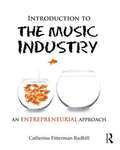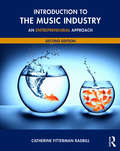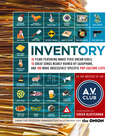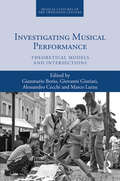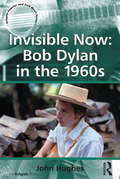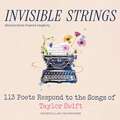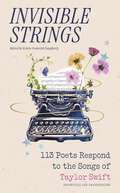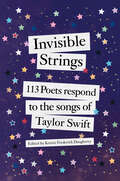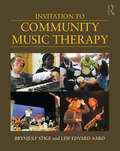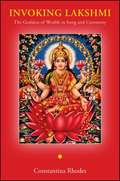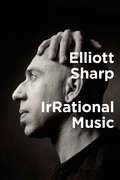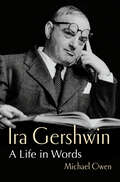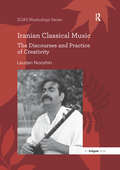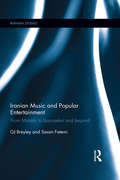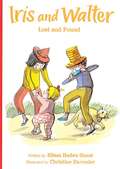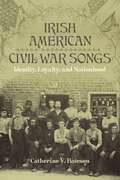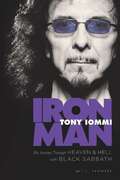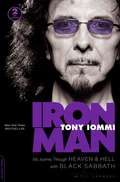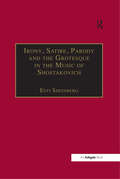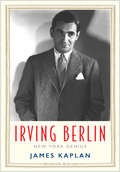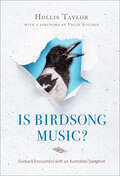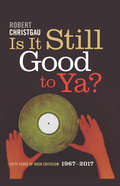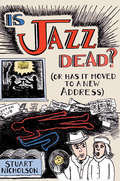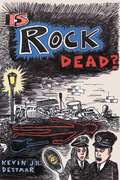- Table View
- List View
Introduction to the Music Industry: An Entrepreneurial Approach
by Catherine Fitterman RadbillIntroduction to the Music Industry: An Entrepreneurial Approach is an introductory textbook that offers a fresh look at one of the fastest-changing businesses in the world today. Emphasizing the importance of entrepreneurial thinking for the music industry, this textbook engages college-level students in learning the fundamentals of the music business while discovering ways to shape the industry's future. Every chapter explores the inner workings of the music industry, using creative problem-solving exercises, discussion questions, collaborative projects, case studies, hands-on activities, and inspiring stories of actual music entrepreneurs. The textbook's companion website provides multi-media content, study guides, and an instructor's manual with lesson plans and suggestions for assessing students' work. This book will be beneficial to students who want to learn the basics of the music industry and be involved in some way, whether a professional working in support of artists, or an artist trying to launch his or her performing career.
Introduction to the Music Industry: An Entrepreneurial Approach, Second Edition
by Catherine Fitterman RadbillIntroduction to the Music Industry: An Entrepreneurial Approach, Second Edition is an introductory textbook that offers a fresh perspective in one of the fastest-changing businesses in the world today. It engages students with creative problem-solving activities, collaborative projects and case studies as they explore the inner workings of the music business, while encouraging them to think like entrepreneurs on a path toward their own successful careers in the industry. This new edition includes a revised chapter organization, with chapters streamlined to focus on topics most important to music business students, while also maintaining its user-friendly chapter approach. Supported by an updated companion website, this book equips music business students and performance majors with the knowledge and tools to adopt and integrate entrepreneurial thinking successfully into practice and shape the future of the industry.
Inventory
by Chuck Klosterman A. V. ClubEach week, the writers of The A.V. Club issue a slightly slanted pop-culture list filled with challenging opinions (Is David Bowie's "Young Americans" nearly ruined by saxophone?) and fascinating facts. Exploring 24 great films too painful to watch twice, 14 tragic movie-masturbation scenes, 18 songs about crappy cities, and much more, Inventory combines a massive helping of new lists created especially for the book with a few favorites first seen at avclub.com and in the pages of The A.V. Club's sister publication, The Onion. But wait! There's more: John Hodgman offers a set of minutely detailed (and probably fictional) character actors. Patton Oswalt waxes ecstatic about the "quiet film revolutions" that changed cinema in small but exciting ways. Amy Sedaris lists 50 things that make her laugh. "Weird Al" Yankovic examines the noises of Mad magazine's Don Martin. Plus lists from Paul Thomas Anderson, Robert Ben Garant, Tom Lennon, Andrew W.K., Tim and Eric, Daniel Handler, and Zach Galifianakis -- and an epic foreword from essayist Chuck Klosterman.
Investigating Musical Performance: Theoretical Models and Intersections (Musical Cultures of the Twentieth Century)
by Gianmario Borio Giovanni Giuriati Alessandro Cecchi Marco LutzuInvestigating Musical Performance considers the wide range of perspectives on musical performance made tangible by the cross-disciplinary studies of the last decades and encourages a comparison and revision of theoretical and analytical paradigms. The chapters present different approaches to this multi-layered phenomenon, including the results of significant research projects. The complex nature of musical performance is revealed within each section which either suggests aspects of dialogue and contiguity or discusses divergences between theoretical models and perspectives. Part I elaborates on the history, current trends and crucial aspects of the study of musical performance; Part II is devoted to the development of theoretical models, highlighting sharply distinguished positions; Part III explores the relationship between sign and sound in score-based performances; finally, the focus of Part IV centres on gesture considered within different traditions of musicmaking. Three extra chapters by the editors complement Parts I and III and can be accessed via the online Routledge Music Research Portal. The volume shows actual and possible connections between topics, problems, analytical methods and theories, thereby reflecting the wealth of stimuli offered by research on the musical cultures of our times.
Invisible Now: Bob Dylan In The 1960s (Ashgate Popular and Folk Music Series)
by John HughesInvisible Now describes Bob Dylan's transformative inspiration as artist and cultural figure in the 1960s. Hughes identifies Dylan's creativity with an essential imaginative dynamic, as the singer perpetually departs from a former state of inexpression in pursuit of new, as yet unknown, powers of self-renewal. This motif of temporal self-division is taken as corresponding to what Dylan later referred to as an artistic project of 'continual becoming', and is explored in the book as a creative and ethical principle that underlies many facets of Dylan's appeal. Accordingly, the book combines close discussions of Dylan's mercurial art with related discussions of his humour, voice, photographs, and self-presentation, as well as with the singularities of particular performances. The result is a nuanced account of Dylan's creativity that allows us to understand more closely the nature of Dylan's art, and its links with American culture.
Invisible Strings: 113 Poets Respond to the Songs of Taylor Swift
by Kristie Frederick DaughertyThere is always a link. This is the magic of Taylor Swift . . . She has trained her fans to follow her threads.An anthology of 113 brand new poems. Responding to 113 songs by Taylor Swift. Can you match every poem to the song that inspired it? Including brand new work from a powerhouse group of poets, including Diane Seuss, Amanda Lovelace, Hollie McNish, Richard Siken, Ilya Kaminsky, Joy Harjo, Lang Leav, Paul Muldoon, Maggie Smith, Jane Hirshfield and Yusef Komunyakaa . . .'If you like Taylor Swift easter eggs, this is the book for you... beautiful, thought-provoking and so much fun!'⭐⭐⭐⭐⭐'If you're a fan of Swift's music, you'll find yourself enchanted by this collection... a one-of-a-kind experience'⭐⭐⭐⭐⭐'Poetry meets pop brilliance... a must-read for Swifties and poetry enthusiasts alike'⭐⭐⭐⭐⭐--- With a record-breaking four Grammy awards for Album of the Year, Taylor Swift's lyrics have been heard by millions around the world - clever, authentic, and elegantly written, to her fans these songs are a kind of modern poetry. In Invisible Strings, poet, professor and dedicated Swiftie Kristie Frederick-Daugherty has brought together 113 new poems, each inspired by a particular Taylor Swift song. Taking a cue from Taylor's love of clues and puzzles, test your knowledge of every era - from Fearless to folklore, Reputation to The Tortured Poets Department, vault tracks included - to match each poem to the song it is a response to. For Swifties, this is a creative and affectionate reimagining of their favourite writer's iconic discography - with a chance to see these songs in a brand new way. For poetry lovers, this one-of-a-kind anthology is an unparalleled collection of new work from some of the most lauded and exciting voices in contemporary poetry.
Invisible Strings: 113 Poets Respond to the Songs of Taylor Swift
by Kristie Frederick DaughertyThere is always a link. This is the magic of Taylor Swift . . . She has trained her fans to follow her threads.An anthology of 113 brand new poems. Responding to 113 songs by Taylor Swift. Can you match every poem to the song that inspired it? Including brand new work from a powerhouse group of poets, including Diane Seuss, Amanda Lovelace, Hollie McNish, Richard Siken, Ilya Kaminsky, Joy Harjo, Lang Leav, Paul Muldoon, Maggie Smith, Jane Hirshfield and Yusef Komunyakaa . . .'If you like Taylor Swift easter eggs, this is the book for you... beautiful, thought-provoking and so much fun!'⭐⭐⭐⭐⭐'If you're a fan of Swift's music, you'll find yourself enchanted by this collection... a one-of-a-kind experience'⭐⭐⭐⭐⭐'Poetry meets pop brilliance... a must-read for Swifties and poetry enthusiasts alike'⭐⭐⭐⭐⭐--- With a record-breaking four Grammy awards for Album of the Year, Taylor Swift's lyrics have been heard by millions around the world - clever, authentic, and elegantly written, to her fans these songs are a kind of modern poetry. In Invisible Strings, poet, professor and dedicated Swiftie Kristie Frederick-Daugherty has brought together 113 new poems, each inspired by a particular Taylor Swift song. Taking a cue from Taylor's love of clues and puzzles, test your knowledge of every era - from Fearless to folklore, Reputation to The Tortured Poets Department, vault tracks included - to match each poem to the song it is a response to. For Swifties, this is a creative and affectionate reimagining of their favourite writer's iconic discography - with a chance to see these songs in a brand new way. For poetry lovers, this one-of-a-kind anthology is an unparalleled collection of new work from some of the most lauded and exciting voices in contemporary poetry.
Invisible Strings: 113 Poets Respond to the Songs of Taylor Swift
by Kristie Frederick DaughertyAn anthology of brand-new poems inspired by Taylor Swift songs, from a powerhouse group of contemporary poets, including Kate Baer, Maggie Smith, and Joy Harjo.Let the decoding begin! With a record-breaking four Grammy awards for Album of the Year, Taylor Swift stands alone in the world of pop music. One of the most talented lyricists of all time, her music captivates millions of fans throughout the globe with the narrative depth and emotional resonance of her songwriting.In Invisible Strings, poet, professor, and dedicated Swiftie Kristie Frederick Daugherty has brought together 113 contemporary poets, each contributing an original poem that responds to a specific Taylor Swift song.In a spirit of celebration and collaboration, poets have taken a cue from Swift&’s love of dropping clues and puzzles for her fandom to decode, as each poem alludes to a song without using direct lyrics. Swifties will enjoy closely reading each of the poems to discover which song each poet responded to; each poem responds to only one song.The collection showcases a diverse and accomplished array of writers including the 23rd US Poet Laureate Joy Harjo, Pulitzer Prize winners Diane Seuss, Yusef Komunyakaa, Carl Phillips, Rae Armantrout, Paul Muldoon, and Gregory Pardlo, National Book Critics Circle Award winners Mary Jo Bang and Laura Kasischke, and bestselling poets Maggie Smith, Aimee Nezhukumatathil, Kate Baer, amanda lovelace, Tyler Knott Gregson, and Jane Hirshfield.Swifties will experience the profundity and nuance of Swift&’s lyrics through these poems, while having fun matching the poems to songs from all of her eras—vault tracks included! For poetry lovers, this one-of-a-kind anthology is an unparalleled collection of new work from today&’s most lauded and revered poets.
Invitation to Community Music Therapy
by Brynjulf Stige Leif Edvard AarøInvitation to Community Music Therapy presents the main perspectives and principles of community music therapy as it is practiced around the world. A relatively recent development within the broader field of music therapy, community music therapy emphasizes human connectedness, health promotion, and social change. This textbook surveys the history, theory, and current practice of community music therapy to develop a comprehensive picture of the field. Along the way it takes full measure of the diverse and vibrant ways community music therapy is practiced around the globe. Including dozens of photographs and pedagogical tools such as chapter questions, textboxes, figures, key terms, and discussion topics, Invitation to Community Music Therapy is the ideal introduction to a growing area of music therapy.
Invoking Lakshmi: The Goddess Of Wealth In Song And Ceremony
by Constantina RhodesBeautiful, beloved Lakshmi is the Hindu goddess of wealth, happiness, and abundant good fortune. This fascinating book is the first comprehensive guide to this celebrated goddess, her worship, and the deeper spiritual domain of prosperity she reveals. Constantina Rhodes presents over five hundred elegantly translated Sanskrit verses, including devotional songs, mantras, visualizations, and ceremonial instructions that devotees use to invoke Lakshmi. Rhodes uses these texts to develop a richly detailed portrait of Lakshmi, revealing unexpected dimensions of this enigmatic deity. Even as Lakshmi is best known as a goddess of wealth and well-being, she also maintains a strong esoteric presence, expressing herself as Siddhi, the magnificent Tantric goddess of spiritual power, and as Kundalini Shakti, the transformative cosmic force that exists within each individual. These identities express the prosperity consciousness that is the essential nature of the goddess and the divine source of all wealth. Invoking Lakshmi is not only a matter of calling upon the external form of the goddess but also of aligning one s consciousness with the very essence of prosperity
IrRational Music
by Elliott SharpA memoir and manifesto by a pivotal figure at the junction of rock, the avant-garde, and an ever-widening spiral of art, theater, film, and dance.For over five decades, Elliott Sharp has been engaged in a quest at once quixotic and down to earth: to take the music he hears in his inner ear and bring it to life in the real world. In this vivid memoir and manifesto, Sharp takes us along on that quest, through some of the most rugged, anarchically fertile cultural terrain of our time. Sharp, a mainstay of the New York Downtown scene beginning in the 1980s, has been a pivotal figure at the junction of rock, experimental music, and an ever-widening spiral of art, theater, film, and dance. Rooted in blues, rock, jazz, and the twentieth-century avant-garde, Sharp's innovative music has encompassed fractal geometry, chaos theory, algorithms, genetic metaphors, and new strategies for graphic notation.In IrRational Music, Sharp dodges fake cowboys' real bullets by the side of a highway near Colby, Kansas; is called on the carpet by a prickly, pompadoured Morton Feldman (&“Improvisation… I don't buy it&”); segues from Zen tea to single malt with an elfin John Cage; conjures an extraterrestrial opera from a group of high-school students in Munich; and—back in his own high-school days—looks up from strumming Van Morrison's &“Gloria&” in Manny's Music on 48th Street to see Jimi Hendrix smiling benignly upon him. A mix of tales from the road with thoughts on music, art, politics, technology, and the process of thinking itself, IrRational Music is a glimpse inside the mind of one of our most exacting, exciting creative artists.
Ira Gershwin: A Life in Words
by Michael OwenThe man behind some of the most memorable lyrics in the Great American Songbook steps from behind his brother’s shadow. The first lyricist to win the Pulitzer Prize, Ira Gershwin (1896–1983) has been hailed as one of the masters of the Great American Songbook, a period which covers songs written largely for Broadway and Hollywood from the 1920s to the 1950s. Now, in the first full-length biography devoted to his life, Michael Owen brings Ira out at last from the long shadow cast by his younger and more famous brother George. Drawing on extensive archival sources and often using Ira’s own words, Owen has crafted a rich portrait of the modest man who penned the words to many of America’s best-loved songs, like “Fascinating Rhythm,” “Embraceable You,” and “They Can’t Take That Away from Me.” These fruits of Ira’s lyric genius sprang from the simplest of seeds: a hand-drawn weekly created for a cousin, an amateur newspaper co-written with friend and future lyricist Yip Harburg, columns in the school papers at Townsend Harris High School and, later, City College of New York. The details of his early literary efforts demonstrate both his developing ambition and the early signs of his talent. But while the road to becoming a successful lyricist was neither short nor smooth, it did lead Ira to the greatest creative partnership of his life. George and Ira Gershwin collaborated on a string of hit Broadway shows in the 1920s and 1930s that resulted in popular and financial success and spawned a long string of songs that have become classics. Owen offers fascinating glimpses of their creative process, drawing on Ira’s diaries and other contemporary sources, as well as the close relationship between the two brothers. Hollywood soon beckons and the brothers head west to California to work in the movie business. Greater fame and fortune seem right around the corner. George Gershwin died in a Los Angeles hospital in July 1937. He was only 38 years old. His death marked a stark dividing line in Ira’s life, and from that point on much of his time and energy was devoted to the management of his brother’s estate and the care of his legacy. Accustomed to living in his brother’s shadow, it now threatened to overwhelm him. He worked to balance all the administrative tasks with a new series of collaborations with composers like Kurt Weill, Jerome Kern, Harry Warren, and Harold Arlen. Ira’s last Broadway work was in 1946, and several films and a book project—a collection of his lyrics with the stories behind them—occupied his later years along with the ongoing management of George’s affairs. Ira Gershwin’s work with George left an enduring mark on American culture, as recognized by the Library of Congress in 2007 when it established the Gershwin Prize for Popular Song, which has been awarded to artists like Paul Simon, Carole King, Tony Bennett, Paul McCartney, and Elton John. In Ira Gershwin: A Life in Words, Michael Owen brings the publicity shy lyricist into the spotlight he deserves.
Iranian Classical Music: The Discourses and Practice of Creativity (SOAS Studies in Music Series)
by Laudan NooshinQuestions of creativity, and particularly the processes which underlie creative performance or ’improvisation’, form some of the central areas of interest in current musicology. Yet the predominant discourses on which musicological thought in this area are based have rarely been challenged. In this book Laudan Nooshin interrogates musicological discourses of creativity from the perspective of critical theory and postcolonial studies, examining their ideological underpinnings, the relationships of alterity which they sustain, and the profound implications for our understanding of creative processes in music. The repertoire which forms the book’s main focus is Iranian classical music, a tradition in which the performer plays a central creative role. Addressing a number of issues regarding the nature of musical creativity, the author explores both the discourses through which ideas about creativity are constructed, exchanged and negotiated within this tradition, and the practice by which new music comes into being. For the latter she compares a number of performances by musicians playing a range of instruments and spanning a period of more than 30 years, focusing on one particular section of repertoire, dastgāh Segāh, and providing transcriptions of the performances as the basis for analytical exploration of the music’s underlying compositional principles. This book is about understanding musical creativity as a meaningful social practice. It is the first to examine the ways in which ideas about tradition, authenticity, innovation and modernity in Iranian classical music form part of a wider social discourse on creativity, and in particular how they inform debates regarding national and cultural identity.
Iranian Music and Popular Entertainment: From Motrebi to Losanjelesi and Beyond (Iranian Studies)
by Sasan Fatemi Gj BreyleyThe word motreb finds its roots in the Arabic verb taraba, meaning 'to make happy.' Originally denoting all musicians in Iran, motrebi came to be associated, pejoratively, with the cheerful vulgarity of the lowbrow entertainer. In Iranian Music and Popular Entertainment, GJ Breyley and Sasan Fatemi examine the historically overlooked motrebi milieu, with its marginalized characters, from luti to gardan koloft and mashti, as well as the tenacity of motreb who continued their careers against all odds. They then turn to losanjelesi, the most pervasive form of Iranian popular music that developed as motrebi declined, and related musical forms in Iran and its diasporic popular cultural centre, Los Angeles. For the first time in English, the book makes available musical transcriptions, analysis and lyrics that illustrate the complexities of this history. As it presents the findings of the authors' years of ethnographic work with the history's protagonists, from senior motreb to pop-rock stars, the book reveals parallels between the decline of motrebi and the rise of 'modernity.' In the twentieth century, the fate of Tehran's motrebi music was shaped by the social and urban polarization that ensued from the modern market economy, and losanjelesi would be similarly affected by transnational relations, revolution, war and migration. Through its detailed and informed examination of Iranian popular music, this study reveals much about the values and anxieties of Iranian society, and is a valuable resource for students and scholars of Iranian society and history.
Iris and Walter: Lost and Found
by Elissa Haden Guest Christine DavenierWalter loves his grandmother's harmonica. But when he lets Iris borrow it the night before his grandmother comes to visit, something awful happens--it disappears! How will Iris break the news to Walter?
Irish American Civil War Songs: Identity, Loyalty, and Nationhood (Conflicting Worlds: New Dimensions of the American Civil War)
by Catherine V. BatesonIrish-born and Irish-descended soldiers and sailors were involved in every major engagement of the American Civil War. Throughout the conflict, they shared their wartime experiences through songs and song lyrics, leaving behind a vast trove of ballads in songbooks, letters, newspaper publications, wartime diaries, and other accounts. Taken together, these songs and lyrics offer an underappreciated source of contemporary feelings and opinions about the war.Catherine V. Bateson’s Irish American Civil War Songs provides the first in-depth exploration of Irish Americans’ use of balladry to portray and comment on virtually every aspect of the war as witnessed by the Irish on the front line and home front. Bateson considers the lyrics, themes, and sentiments of wartime songs produced in America but often originating with those born across the Atlantic in Ireland and Britain. Her analysis gives new insight into views held by the Irish migrant diaspora about the conflict and the ways those of Irish descent identified with and fought to defend their adopted homeland. Bateson’s investigation of Irish American song lyrics within the context of broader wartime experiences enhances our understanding of the Irish contribution to the American Civil War. At the same time, it demonstrates how Irish songs shaped many American balladry traditions as they laid the foundation of the Civil War’s musical soundscape.
Iron Man
by Tony IommiIron Man chronicles the story of both pioneering guitarist Tony Iommi and legendary band Black Sabbath, dubbed "The Beatles of heavy metal" by Rolling Stone. Iron Man reveals the man behind the icon yet still captures Iommi's humor, intelligence, and warmth. He speaks honestly and unflinchingly about his rough-and-tumble childhood, the accident that almost ended his career, his failed marriages, personal tragedies, battles with addiction, band mates, famous friends, newfound daughter, and the ups and downs of his life as an artist.Everything associated with hard rock happened to Black Sabbath first: the drugs, the debauchery, the drinking, the dungeons, the pressure, the pain, the conquests, the company men, the contracts, the combustible drummer, the critics, the comebacks, the singers, the Stonehenge set, the music, the money, the madness, the metal.
Iron Man
by Tony IommiThe memoir of one of the great musicians of our time, Tony Iommi?Grammy-winning revolutionary guitarist, cofounding member of Black Sabbath, and architect of heavy metal
Iron Man: My Journey through Heaven and Hell with Black Sabbath
by Tony IommiTony Iommi, rock guitarist and Black Sabbath legend, invented the heavy metal sound that changed rock music forever . . . from working class Midlands roots, Tony Iommi's unique playing style - a result of a disfiguring hand injury he suffered working in a sheet metal factory - created a dark and gothic sound unlike anything that had been heard before, spawning generations of devoted fans. Black Sabbath went on to become a superband, and Iommi led the life of a rockstar to the fullest - with the scars from all the nights of wild excess to show for it. In Iron Man, Iommi goes on the record about Sabbath and tells his story: the life and adventures of one of rock's greatest heroes. 'Tony Iommi is the true father of Heavy Metal, a continuously creative genius riff-meister, and one of the world's great human beings' Brian May 'Without Tony, heavy metal wouldn't exist. He is the creator of heavy! Tony is a legend. He took rock and roll and turned it into heavy metal' Eddie van Halen 'Mr Iommi, aka . . . The riffmaster. It's all his fault I am where I am' James 'papa HET' Hetfield
Irony, Satire, Parody and the Grotesque in the Music of Shostakovich: A Theory of Musical Incongruities
by Esti SheinbergThe music of Shostakovich has been at the centre of interest of both the general public and dedicated scholars throughout the last twenty years. Most of the relevant literature, however, is of a biographical nature. The focus of this book is musical irony. It offers new methodologies for the semiotic analysis of music, and inspects the ironical messages in Shostakovich‘s music independently of political and biographical bias. Its approach to music is interdisciplinary, comparing musical devices with the artistic principles and literary analyses of satire, irony, parody and the grotesque. Each one of these is firstly inspected and defined as a separate subject, independent of music. The results of these inspections are subsequently applied to music, firstly music in general and then more specifically to the music of Shostakovich. The composer‘s cultural and historical milieux are taken into account and, where relevant, inspected and analysed separately before their application to the music.
Irving Berlin: New York Genius (Jewish Lives)
by James KaplanFrom the prizewinning Jewish Lives series, a fast‑moving, musically astute portrait of arguably the greatest composer of American popular music Irving Berlin (1888–1989) has been called—by George Gershwin, among others—the greatest songwriter of the golden age of the American popular song. &“Berlin has no place in American music,&” legendary composer Jerome Kern wrote; &“he is American music.&” In a career that spanned an astonishing nine decades, Berlin wrote some fifteen hundred tunes, including &“Alexander&’s Ragtime Band,&” &“God Bless America,&” and &“White Christmas.&” From ragtime to the rock era, Berlin&’s work has endured in the very fiber of American national identity. Exploring the interplay of Berlin&’s life with the life of New York City, noted biographer James Kaplan offers a visceral narrative of Berlin as self‑made man and witty, wily, tough Jewish immigrant. This fast‑paced, musically opinionated biography uncovers Berlin&’s unique brilliance as a composer of music and lyrics. Masterfully written and psychologically penetrating, Kaplan&’s book underscores Berlin&’s continued relevance in American popular culture.About Jewish Lives: Jewish Lives is a prizewinning series of interpretative biography designed to explore the many facets of Jewish identity. Individual volumes illuminate the imprint of Jewish figures upon literature, religion, philosophy, politics, cultural and economic life, and the arts and sciences. Subjects are paired with authors to elicit lively, deeply informed books that explore the range and depth of the Jewish experience from antiquity to the present. In 2014, the Jewish Book Council named Jewish Lives the winner of its Jewish Book of the Year Award, the first series ever to receive this award.More praise for Jewish Lives: &“Excellent.&” – New York times &“Exemplary.&” – Wall St. Journal &“Distinguished.&” – New Yorker &“Superb.&” – The Guardian
Is Birdsong Music?: Outback Encounters with an Australian Songbird (Music, Nature, Place)
by Philip Kitcher Hollis TaylorHow and when does music become possible? Is it a matter of biology, or culture, or an interaction between the two? Revolutionizing the way we think about the core values of music and human exceptionalism, Hollis Taylor takes us on an outback road trip to meet the Australian pied butcherbird. Recognized for their distinct timbre, calls, and songs, both sexes of this songbird sing in duos, trios, and even larger choirs, transforming their flute-like songs annually. While birdsong has long inspired artists, writers, musicians, and philosophers, and enthralled listeners from all walks of life, researchers from the sciences have dominated its study. As a field musicologist, Taylor spends months each year in the Australian outback recording the songs of the pied butcherbird and chronicling their musical activities. She argues persuasively in these pages that their inventiveness in song surpasses biological necessity, compelling us to question the foundations of music and confront the remarkably entangled relationship between human and animal worlds. Equal parts nature essay, memoir, and scholarship, Is Birdsong Music? offers vivid portraits of the extreme locations where these avian choristers are found, quirky stories from the field, and an in-depth exploration of the vocalizations of the pied butcherbird.
Is It Still Good to Ya?: Fifty Years of Rock Criticism, 1967-2017
by Robert ChristgauIs It Still Good to Ya? sums up the career of longtime Village Voice stalwart Robert Christgau, who for half a century has been America's most widely respected rock critic, honoring a music he argues is only more enduring because it's sometimes simple or silly. While compiling historical overviews going back to Dionysus and the gramophone along with artist analyses that range from Louis Armstrong to M.I.A., this definitive collection also explores pop's African roots, response to 9/11, and evolution from the teen music of the '50s to an art form compelled to confront mortality as its heroes pass on. A final section combines searching obituaries of David Bowie, Prince, and Leonard Cohen with awed farewells to Bob Marley and Ornette Coleman.
Is Jazz Dead?: Or Has It Moved to a New Address
by Stuart NicholsonIs Jazz Dead? examines the state of jazz in America at the turn of the twenty-first century. Musicians themselves are returning to New Orleans, Swing, and Bebop styles, while the work of the '60s avant-garde and even '70s and '80s jazz-rock is roundly ignored. Meanwhile, global jazz musicians are creating new and exciting music that is just starting to be heard in the United States, offering a viable alternative to the rampant conservatism here. Stuart Nicholson's thought-provoking book offers an analysis of the American scene, how it came to be so stagnant, and what it can do to create a new level of creativity. This book is bound to be controversial among jazz purists and musicians; it will undoubtedly generate discussion about how jazz should grow now that it has become a recognized part of American musical history. Is Jazz Dead? dares to ask the question on all jazz fan's minds: Can jazz survive as a living medium? And, if so, how?
Is Rock Dead?
by Kevin J.H. DettmarRock and roll's death has been forecast nearly since its birth; the country song "The Death of Rock and Roll" appeared in September 1956, showing that the music had already outraged a more conservative listening audience. Is Rock Dead? sets out to explore the varied and sometimes conflicting ways in which the death of rock has been discussed both within the discourse of popular music and American culture. If rock is dead, when did it die? Who killed it? Why do rock journalists lament its passing? Has its academic acceptance stabbed it in the back or resuscitated an otherwise lifeless corpse? Why is rock music the music that conservatives love to hate? On the other side of the coin, how have rock's biggest fans helped nail shut the coffin? Does rock feed on its own death-and-rebirth? Finally, what signs of life are there showing that rock, in fact, is surviving?Is Rock Dead? will appeal to all those who take seriously the notion that rock is a serious musical form. It will appeal to students of popular music and culture, and all those who have ever spun a 45, cranked up the radio, or strummed an air guitar.
